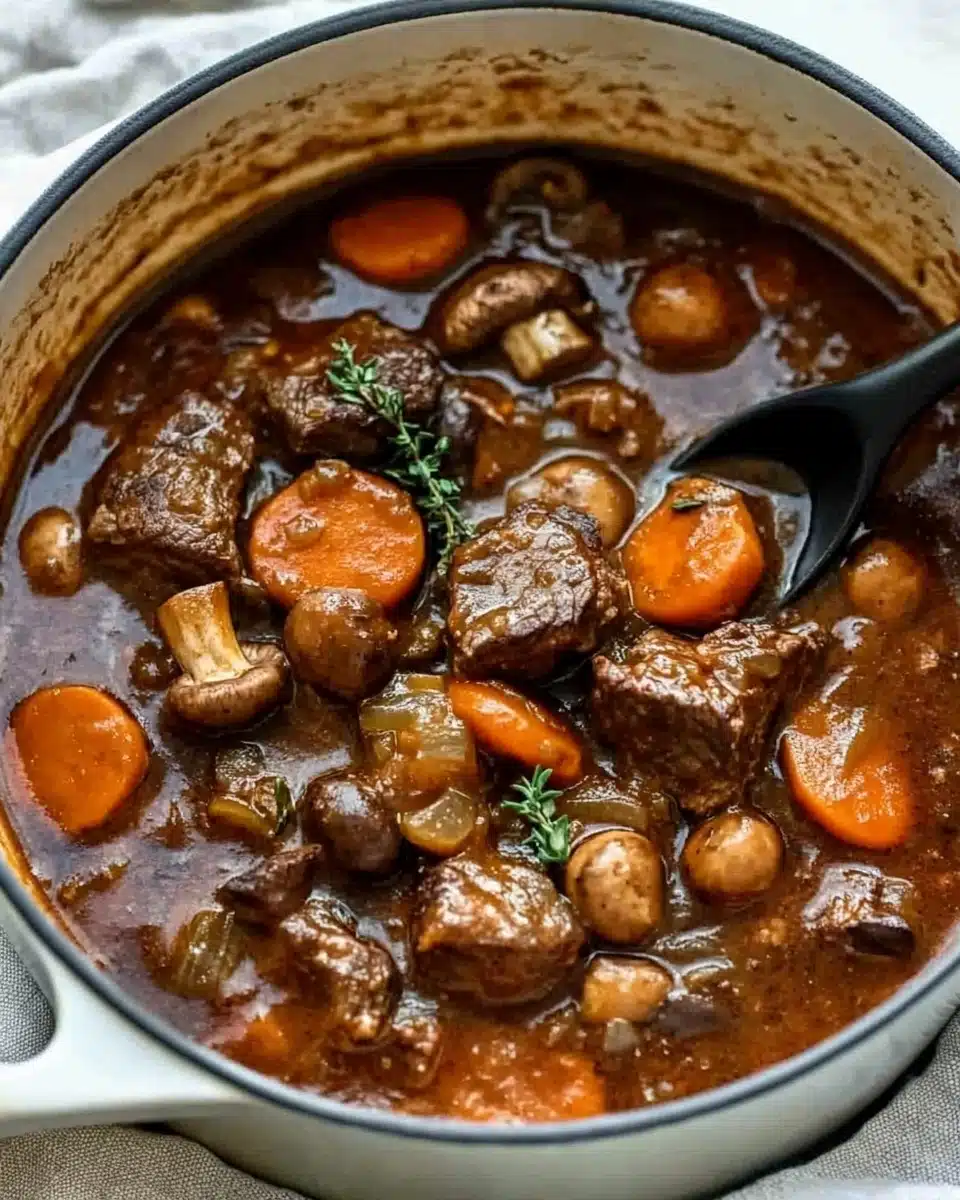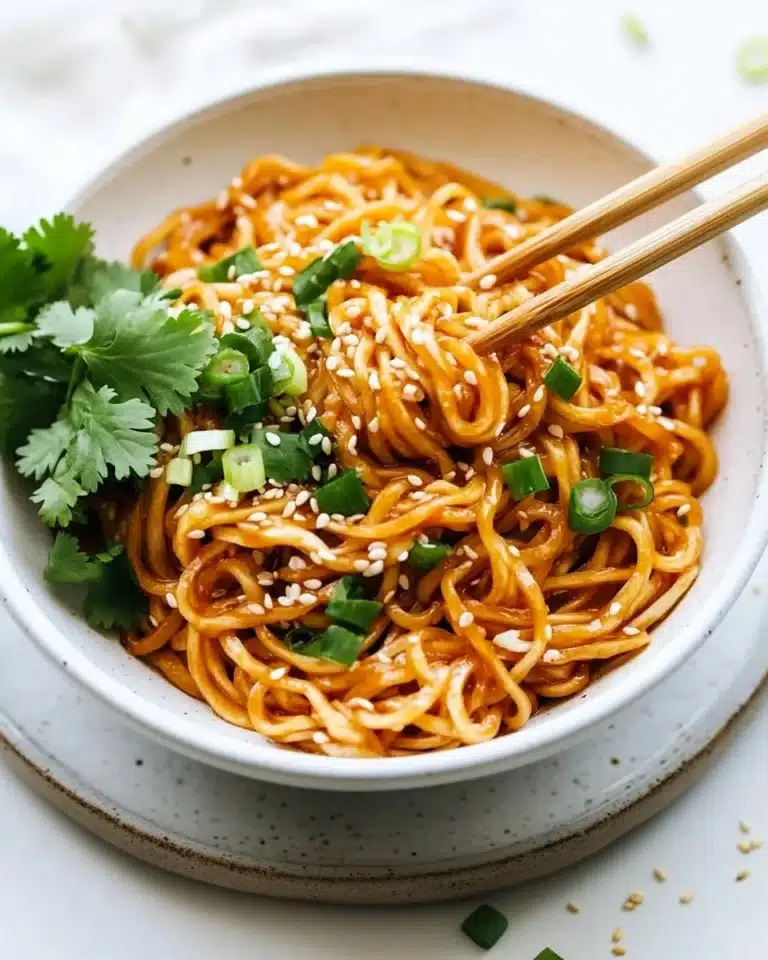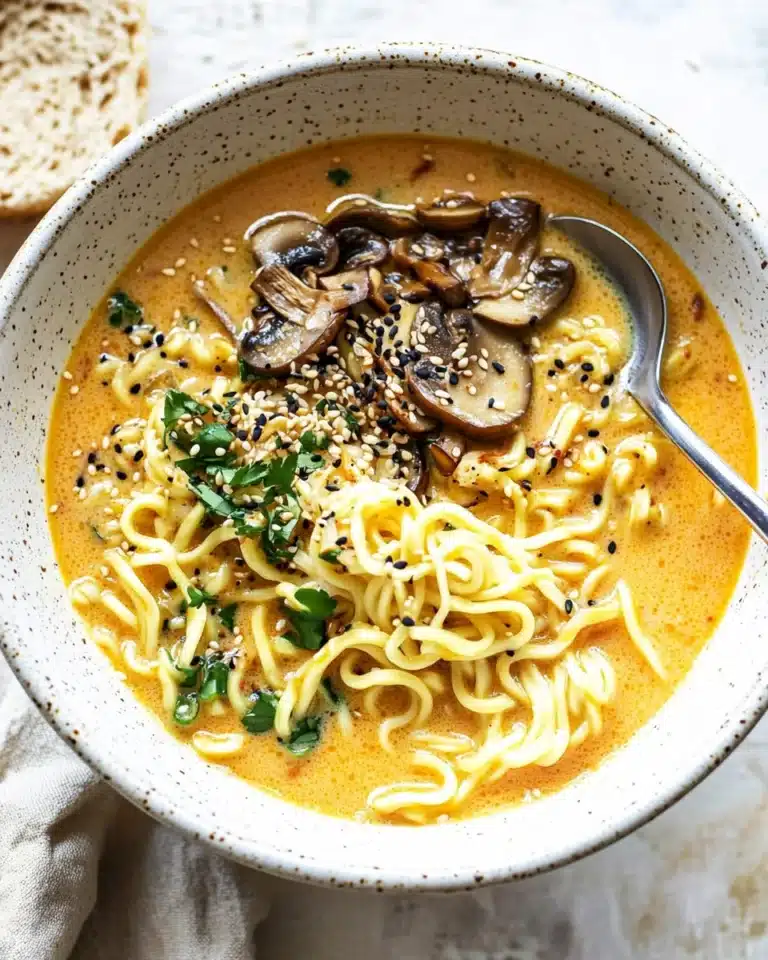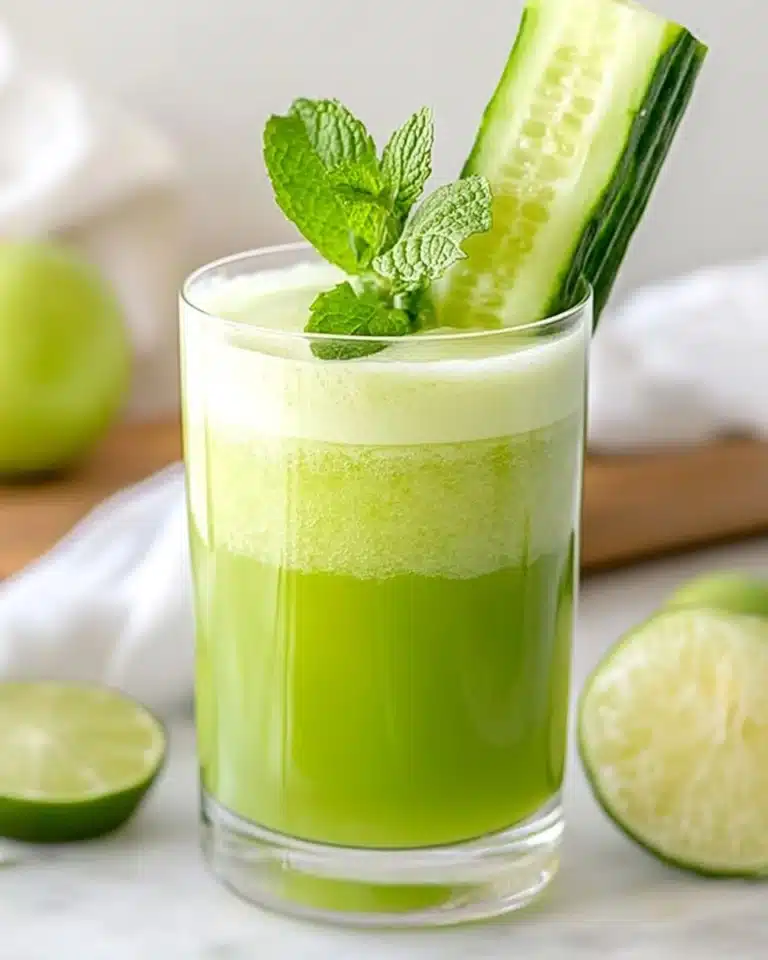Ready to savor a dish that’s as comforting as a warm hug on a chilly day? Dive into the delicious world of Beef Carbonnade, a heartwarming Belgian stew that brings together the robust flavors of beef, beer, and herbs in one soul-soothing pot. It’s a family favorite that will undoubtedly become a staple at your dinner table.
Why You’ll Love This Recipe
- Rich, Deep Flavors: The combination of beef, beer, and herbs creates a depth of flavor that’s incredibly satisfying.
- Comfort in a Bowl: It’s the ultimate comfort food, perfect for warming up on cold evenings.
- Easy to Prepare: With a few simple steps, you’ll have a meal that tastes like it’s taken hours to prepare.
- Make-Ahead Magic: Tastes even better the next day, making it ideal for meal prepping.
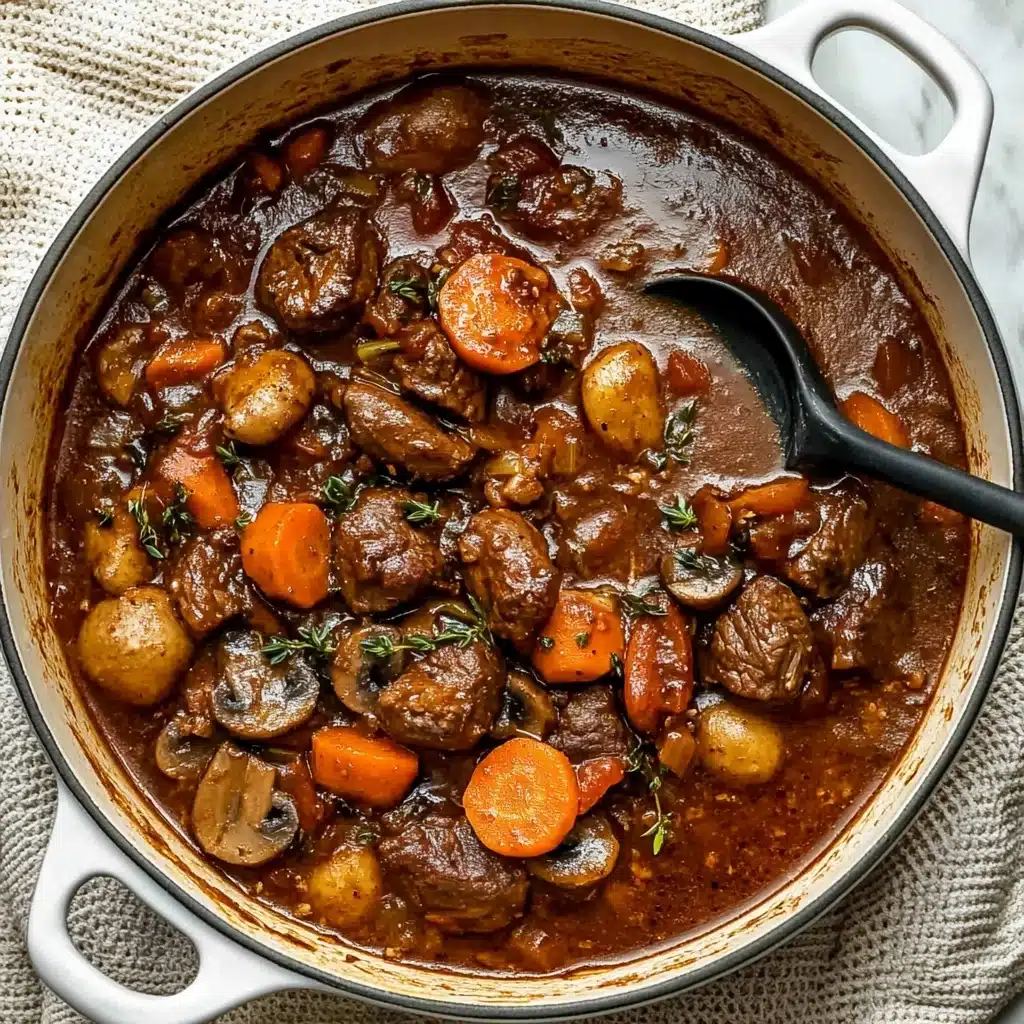
Ingredients You’ll Need
Crafting a memorable Beef Carbonnade doesn’t require a long shopping list. Each ingredient plays a pivotal role in building the layers of flavor, from the richness of the beef to the earthy aroma of fresh herbs. Let’s take a look at what you’ll need.
- Beef Short Ribs: These are the star of the show, offering a tender, succulent bite after slow cooking.
- Olive Oil: For browning the meat and adding a subtle richness to the stew.
- Plain/All-Purpose Flour: Perfect for creating a delicious crust on the beef and thickening the sauce slightly.
- Carrots, Onions, and Mushrooms: These veggies add sweetness and an earthy depth to the dish.
- Speck: A smoky, bacon-like element that provides a lovely flavor complexity.
- Tomato Paste and Garlic: They lay the foundational flavor balance of acidity and sweetness.
- Wholegrain Mustard: Adds a tangy kick that works wonders with the other ingredients.
- Herbs (Thyme and Rosemary): Fresh is best for delivering the vivid herbal notes.
- Beef Stock: Rounds everything out, making sure every bite of Beef Carbonnade is packed with flavor.
Variations
One of the joys of cooking Beef Carbonnade is its adaptability! Feel free to make it your own by tweaking the ingredients to suit your taste buds or dietary needs. Here are some delightful variations you can try.
- Vegetarian Twist: Swap out the beef for hearty vegetables like portobello mushrooms and eggplant for a vegetarian version that’s equally delicious.
- Spicy Kick: Add a few dashes of hot sauce or a sprinkle of chili flakes for those who love a little heat.
How to Make Beef Carbonnade
Step 1: Preheat and Prep
Start by preheating your oven to 160°C (320°F). This gentle heat will work magic, tenderizing your beef to melt-in-the-mouth perfection. While the oven gets ready, cut the beef into individual ribs and dust them with flour. This step ensures they form a lovely crust while browning, locking in all those precious juices.
Step 2: Brown the Beef
Heat the olive oil in a large flameproof casserole dish. Fry the ribs in batches, letting them get a deep, golden color all over. This step is crucial, as it sets the stage for that rich, beefy flavor we’ll enjoy later. Once browned, set them aside on a plate.
Step 3: Cook the Vegetables
To the same pot, add carrots, onions, mushrooms, and speck. Sauté until the vegetables soften, caramelizing and picking up all those flavorful bits left behind by the beef. Stir in the tomato paste and crushed garlic for a burst of umami goodness, cooking them just enough to take off the raw edge.
Step 4: Simmer and Bake
Mix in the mustard and herbs, following with the beef stock. Return the ribs to the pot, ensuring they are submerged in the aromatic sauce. Bring to a simmer, then cover and transfer to the oven to bake for about two hours, or until the meat is exquisitely tender.
Pro Tips for Making Beef Carbonnade
- Get a Good Sear: Browning the meat deeply enhances the dish’s flavor profile significantly. Give those ribs enough time to develop a golden crust.
- Quality Beer Matters: Opt for a flavorful beer that you enjoy drinking; its taste will permeate the stew.
- Thickness Control: For a thicker sauce, remove lids towards the end or simmer on the stove to reduce further.
- Experiment with Herbs: Fresh herbs elevate the dish. Try a mix of thyme and rosemary for a vibrant, aromatic finish.
How to Serve Beef Carbonnade
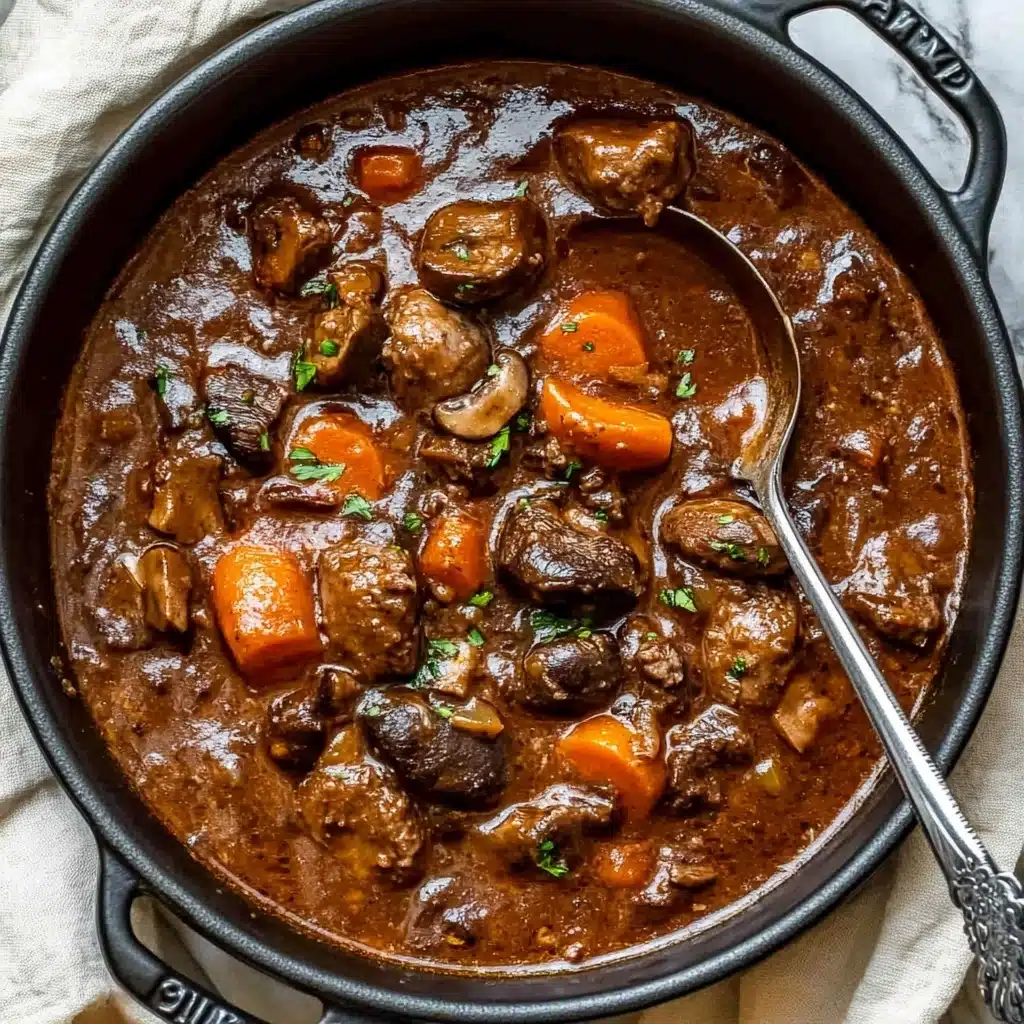
Garnishes
A sprinkle of fresh parsley not only adds a pop of color but also a fresh herbaceous counterpoint to the rich, savory notes of the stew. A dollop of crème fraîche could add a creamy tang that balances the flavors beautifully.
Side Dishes
Pair your Beef Carbonnade with a side of buttery mashed potatoes, crusty bread, or fluffy rice to soak up that glorious sauce. Even a simple green salad can provide a crisp, light contrast to the richness of the stew.
Creative Ways to Present
For a rustic touch, serve your dish straight from the casserole on a wooden board with a ladle, inviting everyone to dig in family-style. Alternatively, for a refined dinner party, plate each portion with precision, using a drizzle of reduced sauce around the edges for a gourmet touch.
Make Ahead and Storage
Storing Leftovers
Store leftover Beef Carbonnade in an airtight container in the refrigerator for up to 3 days. This dish actually tastes even better the day after, as the flavors meld beautifully overnight.
Freezing
You can freeze cooked Carbonnade for up to 3 months. Make sure to cool it completely before transferring it to freezer-safe containers. Thaw it in the fridge overnight before reheating.
Reheating
Reheat the stew gently on the stovetop over low heat, stirring occasionally. Alternatively, you can use the microwave: heat on medium power in short intervals, stirring in between, to ensure even warming.
FAQs
-
Can I use a different cut of beef?
Yes, chuck roast or blade steak can work well, though the cooking time may vary slightly to achieve the same level of tenderness.
-
What kind of beer is best for Beef Carbonnade?
While a lager is commonly used, any beer with flavors you enjoy drinking, like a stout for a deeper, richer profile, can be used.
-
Can this dish be made in a slow cooker?
Absolutely, after browning the ingredients, transfer everything to a slow cooker and cook on low for 6-8 hours until the beef is tender.
-
Is there a substitute for speck?
If speck isn’t available, thick-cut bacon or pancetta make excellent alternatives, adding that vital smoky note.
Final Thoughts
I hope this Beef Carbonnade recipe sparks joy and warmth in your home, just as it has in mine. It’s a dish that’s not only filled with flavorful magic but with the love and warmth that makes every meal special. Go ahead and try it—you won’t be disappointed!
Print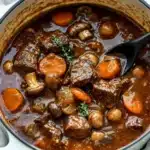
Beef Carbonnade Recipe
- Prep Time: 15 minutes
- Cook Time: 2 hours
- Total Time: 2 hours 15 minutes
- Yield: 4 servings 1x
- Category: Main Course
- Method: Braising
- Cuisine: Belgian-inspired
Description
Beef Carbonnade is a hearty and flavorful Belgian-inspired braised beef dish cooked slowly until tender. Loaded with rich flavors from vegetables, speck, and herbs, this comforting casserole is perfect for a cozy dinner. The beef is seared and simmered in a savory sauce made with beef stock, tomato paste, mustard, and fresh herbs, resulting in a melt-in-your-mouth meal with deep, savory notes.
Ingredients
Meat and Flour
- 1.5 kg beef short ribs – trimmed (3.3 lbs)
- 2 tablespoons olive oil
- 1/4 cup plain/all purpose flour
Vegetables
- 1 large carrot, diced
- 2 brown onions, sliced
- 300 g button mushrooms (if small, leave whole; or thickly sliced)
Meat and Seasonings
- 150 g speck, diced
- 2 tablespoons tomato paste
- 2 fresh garlic cloves, crushed
- 2 tablespoons wholegrain mustard
- 1 tablespoon fresh thyme leaves or 1 teaspoon dried thyme
- 1 tablespoon fresh rosemary, finely chopped
Liquid
- 500 ml beef stock
Salt & Pepper
- Salt and pepper to taste
Instructions
- Preheat oven: Preheat your oven to 160°C (320°F). This ensures a consistent, slow cooking environment for tender beef.
- Prepare beef: Cut the beef into individual short ribs and dust them evenly in the plain flour, which helps in browning and thickening the sauce later.
- Brown the beef: Heat 1 tablespoon of olive oil in a large flameproof casserole or Dutch oven over medium-high heat. Fry the ribs in batches until they develop a deep, caramelized brown color on all sides. Remove from the dish and set aside.
- Sauté vegetables and speck: In the same dish, add diced carrot, sliced brown onions, mushrooms, and diced speck. Cook until vegetables begin to soften and develop flavor, about 5-7 minutes.
- Add tomato paste and garlic: Stir in the tomato paste and crushed garlic cloves, cooking for about 30 seconds to release their aromas.
- Incorporate herbs and mustard: Add wholegrain mustard, fresh thyme leaves, and chopped rosemary. Stir well, scraping any flavorful browned bits from the bottom of the pot.
- Add liquid and simmer: Pour in the beef stock, then return the browned beef ribs and their juices to the dish. Bring to a gentle simmer.
- Bake: Cover the dish with a lid or foil and transfer to the preheated oven. Bake for about 2 hours, or until the beef is tender and falling off the bones. If needed, extend cooking by another 30 minutes for extra tenderness.
- Finish and serve: Taste and adjust seasoning with salt and pepper. If a thicker sauce is desired, remove the ribs, then simmer the sauce on the stovetop until it reduces and thickens. Serve hot with your preferred side.
Notes
- Coloring the ribs well during browning enhances flavor; don’t be timid with browning.
- The weight of the ribs includes the bones, so estimates for meat alone may vary.
- Substitute bacon for the speck for a different smoky flavor.
- You can use lager or other beer instead of a non-alcoholic option for added depth.
- If the beef isn’t tender after 2 hours, continue cooking for an additional 30 minutes.
- To thicken the sauce, remove the ribs once cooked and simmer the sauce until it reaches desired consistency.
- Best served with crusty bread, mashed potatoes, or buttered noodles.
Nutrition
- Serving Size: 1 bowl (approx. 400g)
- Calories: 650 kcal
- Sugar: 7 g
- Sodium: 900 mg
- Fat: 40 g
- Saturated Fat: 15 g
- Unsaturated Fat: 20 g
- Trans Fat: 0.5 g
- Carbohydrates: 45 g
- Fiber: 5 g
- Protein: 50 g
- Cholesterol: 130 mg

